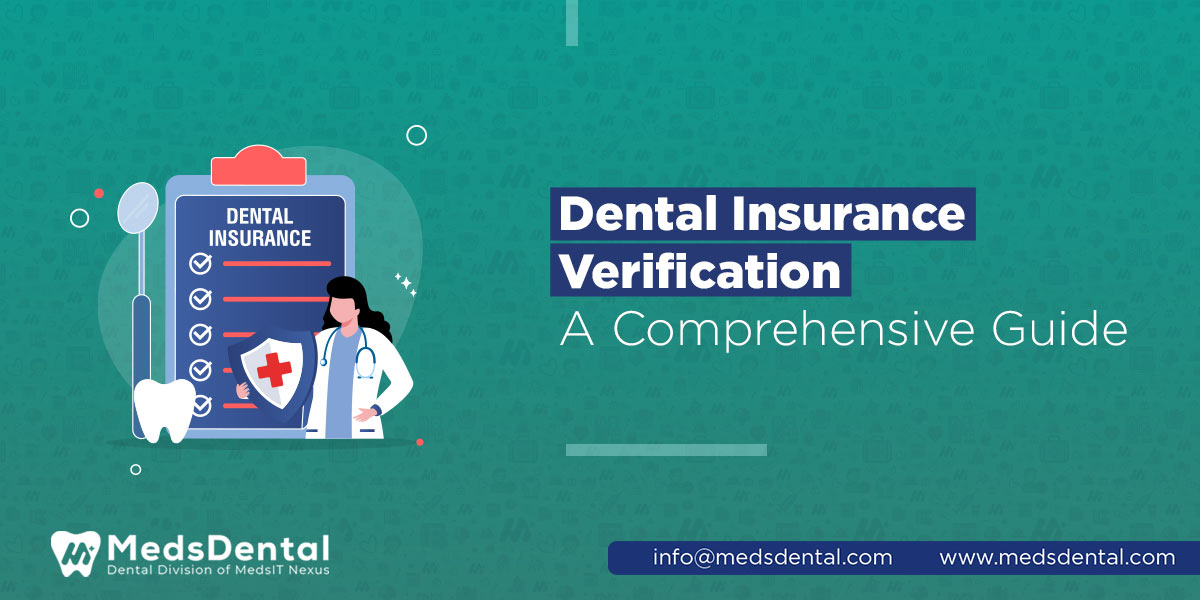

A smooth Dental Insurance Verification process plays a crucial role in the sustainability of a dental practice. It has immense importance for the providers as they have to be reimbursed in accordance with the terms and conditions mentioned in an insurance contract. On the other hand, patients who might not be aware of the exact magnitude of the regulations mentioned in their agreement with payers must also be educated. Any lapse on any part can impact the financial flow of a dental practice. Therefore, experts always advise outsourcing such technical services to dental insurance verification companies. However, as a practitioner, taking on the insurance verification process might be a cost-effective option for some. In such a case, please read this article, as it will provide you with a complete guide on the essentials and how to tackle obstacles in dental insurance verification processes.
Dental Insurance Verification is quite a technical process and navigating its nuances can be too much to ask a beginner for. It requires seasoned professionals to deal with it properly. There are 4 essentials that you must consider in the dental insurance verification process.
Deductible refers to an amount that a patient must pay before their contracted payer starts to provide them coverage. Deductibles are usually subjected to renewal on an annual basis, meaning the patient must come to an agreement with the payer regarding deductibles at the start of each new coverage period.
Coinsurance refers to the dental expenses that the patient is responsible for paying after they are done with the deductible. It is a mutually agreed sum of the total cost of a particular service that the patient must pay. It prevents the insurer from being overburdened.
Copays are fixed amounts a patient must pay for specific dental services. This fixed amount is not reliant on the total cost of the procedure. It is a flat fee that patients usually pay at the time of service. However, copays may vary from treatment to treatment in dentistry.
MOOP is the maximum amount of money a patient is bound to pay for a service covered within a specific period. The period, in most cases, is a year. Once the patient reaches their MOOP limit, the insurance provider is compelled to cover the expense of the whole service till the coverage ends. The MOOP limit prevents the burdening of patients with excessive costs.
In this section, we will tell you in detail about the steps involved in the insurance verification process.
The initial phase in dental care gathers precise and complete patient data, including personal particulars, insurance policy specifics, and pertinent identification numbers. The process should be completed erroneously to ensure that healthcare deeply understands the patient's case history, current health status, and potential treatment options. The documentation allows for proper identification and smooth communication in the pecking order of a healthcare system. Through effectively managing this foremost step, healthcare professionals can proceed with a more focused approach. Consider the following options if you prefer innovative means.
After collecting the patient information, contact the concerned payer to verify their coverage and benefits. The verification can occur via various channels, including direct phone calls, online portals, or electronic transactions, depending on the insurer's preferred mode of contact. The providers can investigate different aspects of patient coverage, such as the policy status, starting and expiry dates of coverage, and any specific limitations or exclusions that might affect the scope of benefits. This allows a clearer picture of the insurance coverage and the anticipated medical service to a dental professional.
After knowing the patient's insurance benefits, it's time for the dental insurance eligibility verification involving identifying specific dental procedures or services covered under their insurance plan. You need to thoroughly review even the minor details, including deductibles, co-pays, co-insurance requirements, and any maximum limits or waiting periods applicable to specific treatments. This removes any ambiguity between a payer and a provider regarding the out-of-pocket charges a patient must pay. This simple step upholds clarity and transparency in financial arrangements and facilitates informed decision-making.
In the dental verification process, once the dental office has determined the cost to be paid by the patient and payer, it is essential to explain this to patients in an organized manner. Hiding any extra cost from the patient may result in disagreements, leading to unwanted feuds that tarnish a practice's reputation. The transparency lets patients consider their financial situation while opting for a service. Also, it empowers patients to participate actively in the decision-making process regarding their dental care. This would foster much-needed trust and collaboration.
The dental insurance verification process needs to be penned down accurately. All should be recorded, From minor details to primary coverage, benefit information, and any discussions or agreements reached with the patient. It is not only an excellent dental practice but is also handy in dealing with legal complications. All records should be kept secure in accordance with the HIPPA and discarded after the officially designated period. The PHI of a patient can only be disclosed to legal authorities in extraordinary situations.
Are you an aspiring dentist striving to increase your patient base but worried about the administrative burden of dental insurance verification? Worry not, as Meds Dental offers you an innovative solution to your front desk problems. We will streamline your workload, verifying insurance coverages in no time. Our experienced professionals are keen on details and seldom make mistakes. We believe in leveraging technology to provide you and your patient hassle-free dental insurance verification experience.
© MedsDental. All rights reserved 2026. Powered by MeshSq.